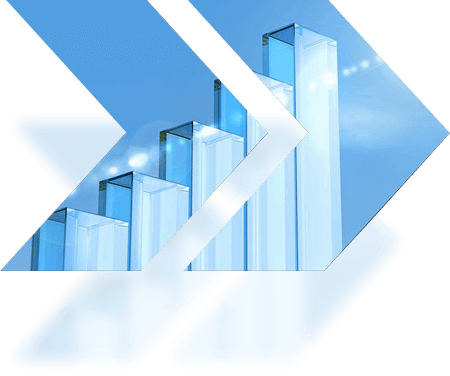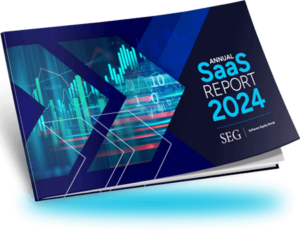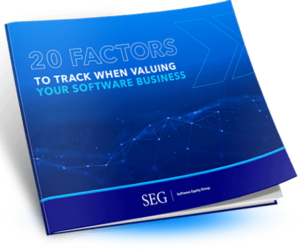Breaking Down Today’s Software Landscape
There’s no denying the uncertainty in the global economy — the S&P 500 index is down 20%, and some blue-chip technology stocks have seen their largest decline in the better part of a decade. For the world of software, we’ve seen a 53% YOY decline in public market EV to revenue multiples in Q2. However, it isn’t all bad news for software businesses, as M&A market multiples are only down 4.5%.
In our own latest survey and analysis of software M&A market trends, while 60% of software investors said they saw a decrease in the volume of high-quality software deals, more than half said that valuations for high quality software companies are unchanged or down less than 10%.
“Even a 20% decline from 2021 climax M&A multiples represents a return to a market that was still fundamentally strong in 2019 and 2020,” says Brad Weekes, SEG Managing Director.
What does this mean for software operators looking to sell at a time like this? Focus on the variables that matter most to investors (more on that later). Remember, during times of macroeconomic uncertainty, software investors favor mission-critical, recession-resistant companies that are efficient and stable.
Q2 of 2022 saw 580 SaaS M&A deals, the second-highest transaction count on record since we began recording data in 2012. PE buyers (who account for 60% of M&A transactions) are looking beyond near-term public market investor changes. The long-term vision of the financial prospects and benefits of investing in SaaS hasn’t changed for investors.
In fact, the change from 2021 might even be good news for SaaS businesses with the right profile, as 40.6% of investors say the deal-making environment for high-quality SaaS companies is less competitive than 2021.

What’s the Buyer Landscape for SaaS?
As a software executive, you’ve likely received various forms of inbound communication from PE’s and strategic buyers alike expressing interest in investing in or acquiring your business. For the typical software executive, these offers usually come from one of two broad sources:
Private equity firms. These include:
- Private equity buyers who make platform acquisitions themselves
- Private equity backed portfolio companies making a tuck-in/add-on acquisition
Strategic buyers. These include:
- Publicly traded strategic companies
- Privately held strategic companies
What to Know About PE Buyers
Unlike the SaaS deals of yesteryear, private equity firms have recently made up the majority of M&A transactions at around 60%. With more resources, record-amounts of capital, and deep experience behind them, their ultimate goal is to increase the value of their investment portfolios by adding fundamentally sound, high-value businesses with the highest potential for ROI.
Today, we see PE buyers continuing to make investments in SaaS as they recognize the stable recurring revenue streams of SaaS businesses and continued long-term growth potential.
Here are a few notable SaaS & software PE deals in 2022:
- 1Q22: Citrix by Vista Equity for $16.5 billion
- 1Q22: Anaplan by Thoma Bravo for $10.4 billion
- 2Q22: Zendesk by Permira for $10.2 billion
The top three most active PE buyers of SaaS in Q2 of 2022 were:
- Vista Equity Partners with 8 acquisitions
- Main Capital Partners with 8 acquisitions
- Thoma Bravo with 7 acquisitions
Download our research reports for more information about the Q1 and Q2 M&A landscape.
What to Know About Strategic Buyers
Strategic buyers have recently made up the minority of SaaS buyers, and their objective is usually to plug existing product gaps or use an acquisition to enter new markets. While the slight minority in SaaS M&A, strategic buyers are more likely than PE buyers to prioritize product and business model value-adds in addition to revenue growth and profitability.
Notable strategic deals in 2022:
- 1Q22: CloudMed by R1 for $4 billion
- 2Q22: Datto by Kaseya for $6.2 billion
- 2Q22: Black Knight by Ice for $16 billion
Active strategic buyers of SaaS in Q2 of 2022:
- Visma with 11 acquisitions
- Microsoft with 7 acquisitions
- Volaris with 7 acquisitions
Download our research reports for more information about the Q1 and Q2 M&A landscape.

What Buyers & Investors Look for in a Software Business
What do buyers and investors look for in a software business when it comes time for an M&A process? While there are many metrics and methods out there to prove value, at a high-level, investors and buyers alike love software businesses because all software businesses have these four things:
- Predictable revenue. Buyers always focus on ARR as a measure of revenue predictability. Subscription recurring revenue models are highly predictable streams of income and as a result, are highly valued in M&A.
- Capital efficiency. Software and SaaS are coveted because they are capital efficient business models. Due to the cloud delivery model and the low impact nature of utilizing software to serve customers, the cost of goods sold for SaaS businesses are much leaner than other industries at scale, creating high gross margins and the opportunity for profitability. Predictable recurring revenue streams allow more opportunity to thoroughly dissect and segment the customer base, enabling an efficient allocation of capital and resources to high value customer cohorts.
- Measurable success. Due to the type of data SaaS companies generate and the most commonly tracked industry metrics being widely available, it is relatively easy to track and benchmark data when compared to other types of businesses.
- Scalability. Lastly, because SaaS businesses can leverage cloud deployment and achieve economies of scale quickly, it is easier and less resource intensive to scale businesses. This enables a greater ability to lean into growth due to the underlying fundamental ability to generate profit at scale.
What key indicators do buyers/investors look for in a software business?
In our latest survey, we asked investors what key metrics they’re prioritizing when it comes to SaaS in the current market. Here are just a few of the changes we’ve seen from recent years, as well as the top-rated indicators of value.
- Gross retention is ranked as most important to 31% of investors today as compared to 11% of investors in 2021.
- Gross margin is ranked as most important to 28% of investors today as compared to just 1% of investors in 2021.
- Revenue growth is as important as ever, with 31% of investors ranking it as most important today and 32% saying it’s most important in 2021.

Vital Metrics for a Company’s Successful Exit
Keeping tabs on the metrics that buyers and investors will emphasize in an M&A process is vital for SaaS executives anticipating an eventual exit. That way, they can keep these areas in mind as they determine business decisions focused to improve the metrics over time.
At SEG, we’ve created a full valuation scorecard with 18 metrics that SaaS founders and operators can use to systematically track their progress over time, and we recently asked investors what metrics are most important to them in a 2022 survey.
Here we break down metrics into both high, medium, and low-value areas across both quantitative and qualitative metrics, with the latest input from investors about what’s important. Here are the top high-value factors to focus on from each.
Quantitative metrics to focus on:
Qualitative metrics to focus on:
- Scalable delivery model. Do you deliver your service on-premise or via the cloud? The cloud is more sustainable in the long run.
- A strong product. How are you able to differentiate your product from others in the market?
- Technology. How innovative is your technology and software as compared to others in the market?
- Mission critical industry or function. How resilient is your industry? We found that ERP, Supply Chain Management, and Security saw the smallest decline in revenue multiples relative to other product categories for public SaaS companies.
Download the full scorecard here. See a term you’re unfamiliar with? Browse our glossary of M&A terms here.

Preparing to Sell Your Software Company
Before we dive into what software executives need to prepare their business for a sale, it’s important to realize that every M&A event is different. The preparation and timing of your M&A transaction will depend on your desired outcomes, which are often as unique as founders themselves.
For example, some executives want to sell to PE firms, others to strategic buyers. Some want to keep equity and stay on to run their business, while some prefer to ride off into the sunset. Regardless of what you prefer, optimizing your exit comes down to your goals, which in turn determine your ultimate exit plan, which in turn shapes your entire exit journey.
Here are four of the first steps you should follow to sell your business.
- Define your objectives. What do you want to get out of selling your company? Are you looking to cash out completely for the largest amount and retire?¬ Do you want to stay loosely involved and roll over some liquidity? Or do you want to continue to run ¬the business and keep a vested interest?
- Know how much your company is worth. You shouldn’t go into an M&A process blind when it comes to potential valuation. Otherwise, you might risk leaving money on the table. Of course, valuations can change. However, you should be familiar with metrics that impact valuation now so you can monitor them. A few to keep in mind include monthly and annual recurring revenue, churn rates, unit economics (payback periods, LTV, CAC), and existing customer base (is it growing or shrinking? Why?).
- Track your metrics. If you’re not tracking key valuation metrics now, start today. See the section above for a few metrics to start tracking, or download our full report on the 18 metrics software executives should track to help with valuation here.
- Get legal right. There are many aspects of legal preparation that software businesses need to consider, including items for employees (HR and benefits), technology (intellectual property and code), customers (contracts and responsibilities), and taxes (nexus in other states or countries). The last thing you want is for legal items to slow down your M&A process. Download our full white paper on how to prepare for M&A legal best practices here.

The 3 Phases of Selling Your Software Company
Now that we’ve broken down the preparation required for a software M&A process, here are three phases software operators can expect to experience when they set out to sell their software business with an advisor like SEG.
Preparation phase
The preparation phase is all about gathering the information and data about the business upfront. It is a detailed process and includes a heavy lift by the advisor to analyze and understand your business, prepare materials including the CIM and data packages, ensure legal and financial information is properly documented, build a targeted buyers list and outreach plan, and properly understand and articulate the opportunities within the business and externally.
This phase includes the preparation of:
- Data packages with complete and detailed customer and financial information
- A buyer outreach plan, including who the advisor will reach out to and what type of buyers the management team is interested in
- A teaser to pique the interest of potential buyers
- The Confidential Information Memorandum (CIM) to position your company as an attractive opportunity for buyers
Marketing phase
After the initial data has been gathered about the business, the marketing phase begins. This includes buyer outreach, where the advisor conducts calls with potential buyers (both pre-and post-NDA), screens potential acquirers, educates the market, answers initial questions, and digests feedback in order to have the best information going forward in the process.
This includes steps like:
- Negotiating NDAs with interested parties
- Sharing the CIM
- Opening round one of the data room (which includes supplemental materials and analysis)
- Management Presentations
- Etc.
As buyers express varying levels of interest, the process proceeds to setting a timeline to receive IOI’s (indications of interest), rounding out round one of the bidding phase. After getting IOI’s, sellers review bids with their advisor and select a smaller group of bidders to advance to the next phase in the process.
Finally, advanced bidders begin the process of moving towards submitting LOI’s (letters of intent. As part of the LOI phase, buyers will review a more detailed round 2 data room and hold -management meetings, among other items. Finally, the sellers receive final offers, negotiate on terms, select one party, and then finalize an LOI with that party, ultimately signing the LOI and entering into due diligence.
Diligence phase
Lastly, the diligence phase of the M&A process begins. Sellers and their advisor build a diligence data room to share with the buyer based upon a detailed diligence request list provided by the buyer, conduct diligence meetings, and go into further negotiations on the purchase agreement. Once diligence is done, the seller and buyer close and sign the agreement and the business is sold!

Why an M&A Advisor Can Help You Sell Your Software Business
We may be biased about this one, but there’s no denying that taking on the sale of your software business is a behemoth endeavor. Software executives need to be aware of just how complicated and time-consuming an M&A process can be — all while they try to run their day-to-day business. Take these two scenarios, for example.
Scenario 1: Selling on your own
A software executive decides to sell on their own. The seller has to compete with the buyers’ years of experience, more resources, and an entire M&A team.
They spend hundreds of hours learning M&A terminology, connecting with and vetting buyers, executing due diligence, and handling negotiations only for the deal to fall through at the last minute. Now they have to start over from square one. Yikes.
Scenario 2: Going with an M&A advisor
A software executive decides to go with SEG as a trusted M&A advisor to help execute a transaction. The management team continues to take care of the day-to-day operations while SEG does the heavy lifting and coordinating throughout the M&A process, including successfully circumventing potential deal-killers and putting 30 years of industry knowledge, relationships, and negotiation skills to use.
SEG dives into the business to creatively position it within the market. The seller ends up with a valuation, deal terms, and exit that they’re happy with.
Our clients go with SEG because we can save them time, money, reduce risk, and leverage existing market knowledge and relationships that sellers might not have access to otherwise to drive the best possible outcome. Going with an M&A advisor can help sellers feel confident in their M&A process from start to finish. Learn more about our M&A services here.

3 Common Questions, Answered
Here are answers to the most common questions we get from software executives about selling their business.
Is it the right time to sell my company?
Timing a sale depends on many different variables, such as your industry, the potential buyers in the space, your product offering, the current market size, etc. Keeping tabs on these and other key customer and financial data, in combination with market data, will give you an indication of when might be the right time to sell.
Remember, businesses with high gross profit margins and high gross revenue retention are currently top priority for investors. Partnering with an M&A advisory firm who keeps tabs on industry trends can help you determine the best time to make the leap.
How big do I have to be to get PE interest?
While there is no hard and fast rule for how big your company needs to be before you generate strategic or PE interest, we typically see businesses with $5 million in revenue as the floor. However, for PEs looking to add on to their existing portfolios, we do occasionally see them go even lower. It all depends on fit and priority.
How do I get an idea of what my company value?
Determining valuation is both an art and a science. To help software executives get a sense of where they stand in the eyes of investors and potential buyers, we created a full guide to valuation with 18 metrics you can start tracking today — download it for free here.
We also recommend talking with an M&A advisor who can examine your metrics, compare them with current public market and M&A multiples, and take into consideration the unique factors of your business, like size, scale, verticals, and more.
At SEG, we have 30 years of experience providing guidance to software executives to understand the M&A market, valuation, buyers, and exit strategy. Our goal is to help good people achieve great things through our creative, honest, and absolutely no-BS approach to M&A advisory services.
If you’re interested in selling your software business and want to see how SEG could make a difference for you, learn more about what we do here.

















